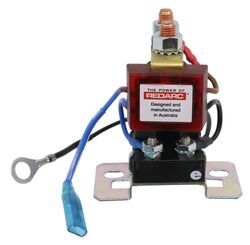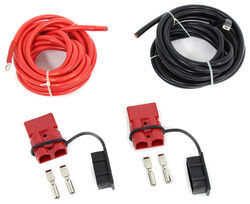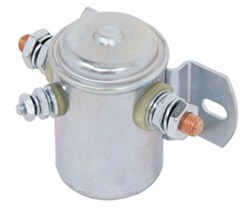
How to Charge Truck Bed Camper Battery from Vehicle
Question:
Thank you for your thorough explanation. I just took the camper in yesterday to the dealer and they did electrical checks on the system and said everything was “up to spec.” They measured 13.4 V coming from the truck at the battery (although I thought I read somewhere that 14.4 was necessary to charge.) One of the things they brought up was that this new lance camper has a lot more gizmos drawing current even when everything is off such as 2 carbon monoxide monitors, smoke alarm, radio, tv, etc. So the bottom line is that you believe the truck’s alternator is capable of keeping the camper battery charged if it’s got sufficient current carrying capacity in the connecting wire. Correct? The reason I ask is I don’t want to spend all the money and take all the time and energy to do the wire upgrade only to find out that there’s just not enough output from the alternator to keep the camper battery charged.
asked by: Clarence
Expert Reply:
You are on the right track to answering your question of "why isn't the battery," being charged as the reason is that the charge circuit of your vehicle just can't carry enough amperage/voltage to keep the battery charged. The reason this is the case for your new setup is most likely because your new camper has a larger battery and/or has appliances that just draw more which uses more of the battery and the current circuit just can't keep up. So the wiring of the 12 volt charge circuit of your vehicle is going to be to thin and ran for too long of a distance to provide an adequate charge.
So the solution is to run a new charge circuit from your vehicle batter/alternator that can deliver enough amperage/voltage to keep the camper battery charged. To do this the new wiring will have to be MUCH heavier than what you currently have. So I recommend 3 gauge winch wiring witch quick disconnects. For that you'd want the part # BDW20025 for a 7-1/2 foot section that will wire to camper battery and then for the section that installs vehicle you'd want the 16 foot long section part # BDW20043. The quick disconnects allow you to easily disconnect the wiring if/when you remove the camper from your truck bed.
Now if you wanted a way to prevent the camper battery from accidentally draining the vehicle battery when it's not running you'd need to install an isolator. For that you'd need the part # 331-SBI12 and you'd be set.

Products Referenced in This Question
Redarc Smart Start Battery Isolator - 12 Volt - 100 Amp
- Battery Charger
- Battery Isolators
- 12V
- Vehicle Battery to Auxiliary Battery
- Redarc
more information >
Bulldog Winch Front Wiring Kit - Quick Connect to Terminal End - 3 Gauge - 7-1/2' Long
- Accessories and Parts
- Electric Winch
- Wiring
- Wiring Kits
- 7-1/2 Feet Long
- 3 Gauge Wire
- Bulldog Winch
more information >
Bulldog Winch Rear Wiring Kit - Quick Connect to Terminal End - 3 Gauge - 16' Long
- Accessories and Parts
- Electric Winch
- Wiring
- Wiring Kits
- 16 Feet Long
- 3 Gauge Wire
- Bulldog Winch
more information >
Product Page this Question was Asked From
Starter Solenoid - SPST - 12 Volt - 100 Amp - Continuous Duty - Grounded
- Accessories and Parts
- Battery Boxes
- Switches and Solenoids
- 100 Amp
- Pollak
more information >
Featured Help Information
Instructions

Continue Researching
- Shop: Trailer Wiring
- Video: Review of TorkLift Hitch Adapters - Ford Super Duty Hitch Extender - TLE1636
- Shop: Suspension Enhancement
- Search Results: locks
- Search Results: s9500
- Search Results: s9700
- Search Results: cannon extension
- Shop: TorkLift Cannon Hitch Extension - 3" Ford Super Duty Factory Hitch - 36" Long
- Video: Review of Timbren Vehicle Rear Axle Suspension -T94VR
- Shop: 40-Amp MIDI Fuse Kit for Redarc In-Vehicle 25-Amp BCDC Battery Charger
- Shop: Hopkins Endurance 5th Wheel/Gooseneck 90-Degree Wiring Harness with 7-Pole Plug
- Shop: TorkLift Wiring Harness Extension for 24" SuperTruss Hitch Extender - 7-Way RV
- Shop: Spectro Ring Terminal - 8 Gauge - 3/8" Ring ID - Copper - Qty 1
- Shop: RV Covers
- Shop: Swing Out Extension Brackets for HappiJac Truck Camper Jack Systems - Qty 2
- Q&A: 7-Way Trailer Plug Adapter or Compatibility with Lance Slide-In Truck Bed Camper
- Q&A: Correct Timbrens for 2004 Dodge Ram 2500 with Slide-In Camper
- Shop: Timbren Suspension Enhancement System - Severe Service - Rear Axle
- Q&A: Recommended Camper Cover For Lance 825 Truck Camper
- Q&A: How To Plug 1997 Lance Truck Camper Into 7-way Connector On 2016 Ford F-250
- Q&A: Reverse Light Pin for Lance Camper 6-Pin Connector
- Shop: Trailer Hitch
- Q&A: How to Charge a Trailer Battery Through a 7-Way Connector
- Shop: Truck Bed Sliding Tray
- Shop: Vehicle Cargo Control
- Shop: Roof Rack
- Article: Wiring Trailer Lights with a 7-Way Plug (It's Easier Than You Think)
- Article: How Much Solar Power Do I Need For My RV?
- Q&A: 2007 Lance 845 Storage Cover Recommendation










Clarence
6/17/2019
Thank you for your thorough explanation. I just took the camper in yesterday to the dealer and they did electrical checks on the system and said everything was “up to spec.” They measured 13.4 V coming from the truck at the battery (although I thought I read somewhere that 14.4 was necessary to charge.) One of the things they brought up was that this new lance camper has a lot more gizmos drawing current even when everything is off such as 2 carbon monoxide monitors, smoke alarm, radio, tv, etc. So the bottom line is that you believe the truck’s alternator is capable of keeping the camper battery charged if it’s got sufficient current carrying capacity in the connecting wire. Correct? The reason I ask is I don’t want to spend all the money and take all the time and energy to do the wire upgrade only to find out that there’s just not enough output from the alternator to keep the camper battery charged.